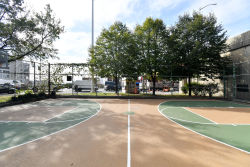Notorious LIC Park
Bridge and Tunnel Park
The “bridge” and “tunnel” in this park’s name refer to Pulaski Bridge and the Queens-Midtown Tunnel, which connect Queens to Brooklyn and to Manhattan, respectively. Both are visible from the park.
The bridge extends over Newtown Creek, which serves as a boundary between Queens and Brooklyn. It was named after Casimir Pulaski (1747-1779), a Polish-born brigadier general known as the “father of American cavalry,” who helped bring the Americans to victory over the British during the Revolutionary War (1776-1783). Pulaski was exiled from Russia after supporting the cause of Polish-Lithuanian freedom. Benjamin Franklin convinced him to come to America, writing that Pulaski’s military experience would be greatly valued. “I came here,” Pulaski wrote in his first letter to General George Washington, “where freedom is being defended, to serve it, and to live and die for it.” Pulaski did, in fact, die for it, receiving a fatal wound at the Battle of Savannah in 1779.
Pedestrians can access the six-lane drawbridge at 11th Street and 50th Avenue in Long Island City, Queens, or at McGuinness Avenue and Freeman Street in Greenpoint, Brooklyn. Every year on the first Sunday of November, New York City Marathon runners know they have reached the halfway mark of the 26.2-mile race when they cross the Pulaski Bridge into Queens.
The Queens-Midtown Tunnel is a double tube tunnel that runs under the East River between 36th Street in Manhattan and Long Island City, Queens. The name’s etymology is more self-explanatory than that of the Pulaski Bridge. It opened to traffic in 1940, and was the third tunnel to provide motor vehicle access to Manhattan. Advanced construction techniques employed by engineer and designer Ole Signstad enabled workers to complete this 1.19 mile (1.92 kilometer) long tunnel in just four years.
The City acquired the land that is now Bridge and Tunnel Park in 1848 by condemnation for the Pulaski Bridge approach. Parks gained jurisdiction over the property in 1957, and subsequently planned a “landscaped sitting area with shade trees and benches.” In 1976, the Triborough Bridge and Tunnel Authority agreed to maintain the park, although Parks would retain jurisdiction over the land. In 1979, Bridge and Tunnel Park opened, equipped with two handball courts and a basketball court.
Check out your park's Vital Signs
Clean & Safe
Green & Resilient
Empowered & Engaged Users
Share your feedback or learn more about how this park is part of a
Vital Park System










